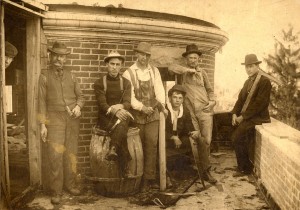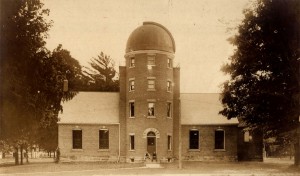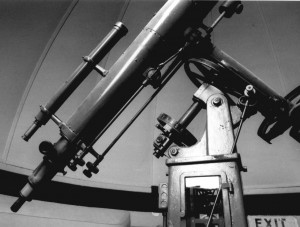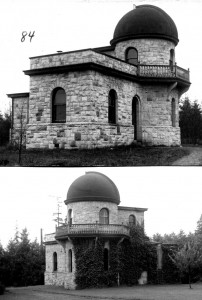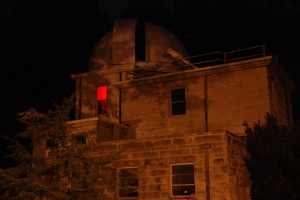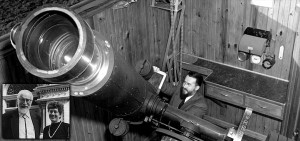
Professor Edmondson at a telescope. Inset with Dr. Caty Pilachowski. Image credit: National Optical Astronomical Observatory News and Reports.
As you can tell from the last few posts, my book collection has grown a bit in the past few weeks, particularly in relation to the history of Harvard Observatory. My partner has been picking up observatory-related books from the local second-hand shop. As it turns out, the books she’s been sorting through were once part of the collection of Frank K. Edmondson, Professor and Chair of Astronomy at Indiana University. Prof. Edmondson did his undergraduate work at IU before earning his Ph.D. from Harvard University, so it’s not unexpected that his library would cover the history of astronomy at either location.
As an undergrad, Edmondson held an assistantship in astronomy, which meant he spent many hours working as a calculator to earn his 25 cents an hour. He was also responsible for opening and managing the Kirkwood Observatory during the weekly public sessions and nightly class meetings. This was on top of his coursework, which was mostly independent study because he was the only astronomy major at IU at the time. He studied almost exclusively under Prof. Wilbur A. Cogshall (see my discussion of the Knightridge Observatory and the Kirkwood Observatory) because, as he stated in an interview conducted in 1977, “Cogshall was the astronomy department.”[1] The 1919 University Bulletin bears out this statement: all fourteen course offerings were taught by Cogshall.[2]
I’ve commented before on the tangled relationships between astronomers and observatories in the U.S. at the end of the nineteenth-beginning of the twentieth century in the United States. University of Washington had close ties with Lick Observatory; Yerkes, Mount Wilson, Palomar, and Hale Solar observatories were tied together through George Ellery Hale; Alvan Clark & Sons designed refracting lenses for the Cincinnati Observatory Center, Yerkes, and Lick Observatory; Warner & Swasey Company built the telescopes at the Lick, Kirkwood, Yerkes and University of Illinois observatories; and so on. Edmondson’s description of his student years at IU brings these interconnections to the forefront as well.
When John Miller (director of the Kirkwood Observatory from 1901-06) began to do double star work in Indiana, he brought on board Wilbur Cogshall, who had been working in Flagstaff as an assistant to T.J.J. See on his double star program. Soon after Cogshall’s arrival, V.M. Slipher (an astronomer originally from Mulberry, Indiana, who is credited with discovering rotational motion in spiral nebulae) graduated from IU. Cogshall used his contacts and got him a job at Flagstaff. The next year (1902), C.O. Lampland graduated from IU and headed off to Flagstaff as well, at Cogshall’s recommendation. E.C. Slipher, the astronomer noted for his observations of Mars and V.M.’s younger brother, followed the same pattern: graduate from IU, head to Lowell Observatory in Flagstaff. Edmondson’s interviewer credited Lowell with bringing together a very “interesting” (and productive) group of scientists at Flagstaff, but Edmondson corrected that assumption, noting that “Yes, well, Cogshall — unless Cogshall had been there, Lowell would never have known about Indiana University, or Slipher or Lampland, if Cogshall had not come there.”
[Interviewer]: “I see, so in a way, it was Cogshall who built the observatory, as far as the staff was concerned.”
[Edmondson]: “That’s right. That’s right. — The three members of the staff, really, when I went out there — well, Arthur Adel was there, I guess, and Clyde Tombaugh — but the three senior members, the two Sliphers and Lampland, were all from Indiana. Then Arthur Adel had gone out there to work with Slipher on planetary spectra, and Tombaugh was there, of course. So your senior staff, for a long period of time, were 100 percent Indiana. As you say, Cogshall built the observatory staff, and that’s it.”
Go, Hoosiers!
The oral histories at the Niel Bohr Library and Archives are priceless. I’m looking forward to digging into Edmondson’s transcript more deeply, particularly for the year he was involved with the development of the NRAO and Green Bank as an NSF officer.
————————————————-
[1] Interview conducted with Edmondson by David DeVorkin in Edmondson’s Office, Swain Hall, Indiana University, 21 April, 1977.
[2] Cogshall had a little bit of help with the teaching. As Edmondson recalls, “K.P. Williams, who was in the mathematics department, taught orbit calculation. Agnes E. Wells, who was dean of women, who had a PhD in astronomy from Michigan, was in the mathematics department, her PhD was in astronomy from Michigan, and she taught history of astronomy. So history of astronomy was Agnes Wells, and orbit calculation was K.P. Williams, and all the rest of the astronomy was Cogshall.”
